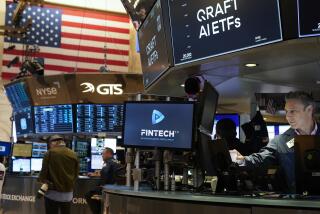Study Stocks Like a Pro
- Share via
If you follow the stock market with any regularity, you’ve probably heard fund managers describe the elaborate criteria they use to pick stocks from the vast universe of investments available.
You can picture them sitting at their computers plugging in secret recipes based on some magical combination of earnings growth, price movement and maybe a dash of trading volume to select the next great stock. Great for them, maybe. But by the time they get to you, the picks are usually stale.
Now, thanks to the Internet, you can try out some of these formulas using fresh data. The software and elaborate databases that once cost thousands of dollars and were accessible only to the pros are now available to individual investors for the cost of a few lattes.
Microsoft Investor (https://investor.msn.com/) offers one of the most comprehensive sets of stock “screening” options for a fee of $9.95 a month.
Choose from a menu of established screens, or filters, based on your investment style. If you are a momentum investor interested in stocks getting a lot of attention on Wall Street, for example, use Microsoft Investor’s Flares model.
A basket of stocks chosen at the beginning of the year using that model, and adjusted every three months, would be up 72% so far this year, according to Jon Markman, Microsoft Investor’s managing editor. Of course, if you chose the Little Monsters screen for small stocks, you would be up only 1.7%.
If you are interested in trying out your own ideas or that of a stock guru you admire, use the site’s Finder option to build your own screen. It takes a while to learn where to click. But with a little practice, you can choose from among 522 criteria that include most of the buzzwords you hear from the fund managers, like “200-day moving average.” Run the screen and, presto, you have your stock selections. Now you can start researching the companies using the rich resources available on financial sites throughout the Web.
A more user-friendly format for building your own stock screen is available at Fortune Investor (https://www.fortuneinvestor.com/). To exploit its full capabilities you have to pay $39.95 a month. But the advantage of the Fortune site is that you can back test your customized stock screen, checking to see how it would have done over the past year.
For some of the most sophisticated screening capabilities, go to Wall Street City (https://www.wallstreetcity.com). The site is the storefront for Houston-based Telescan Inc., which provides the data for the stock analysis capabilities offered by the diverse sites run by Fidelity, Charles Schwab and American Express.
Telescan offers more than 50 screens. Its database includes 20,000 stocks, including many international issues, compared with the 9,000 or so offered by Microsoft’s site. You can pay $39.95 and get about what you get from the Fortune site. But if you pay another $150 a month you can receive their Continuous Alert Telescan Service for day traders that updates your screens every five minutes, signaling to you right away if there is any unusual activity going on in a share price.
Next month, for an additional $15 a month, Telescan will offer features that allow you to back-test screens for three years. Another new feature will allow investors to screen their existing portfolio against various criteria.
“You could run a search for insider trading on your portfolio and it would tell you if there have been significant insider sells on any of your stocks,” says Jerry Smith, vice president for Internet sites at Telescan.
Most of the sites listed above will also help you screen mutual funds. But if you want to go to the source of some of the best information about funds, try Morningstar’s site (https://www.morningstar.com), where for $9.95 you can do screens of both stocks and funds.
The American Assn. of Individual Investors, a national nonprofit group that has long been a proponent of using computers to screen stocks, says the practice has become much more popular as Web sites have made the tools more accessible.
“There has been a significant increase in people using screens because of the lower cost and accessibility of the databases,” says John Bajkowski, editor of the association’s investing newsletter.
Screens also add a disciplined approach to an investor’s buying or selling, says Bajkowski. “If a stock no longer matches your screening criteria, you have to ask why,” he said. “The key is to have the discipline to follow the approach in a wide range of market conditions.”
*
Please send Internet site suggestions to cutting.edge @latimes.com.
More to Read
Inside the business of entertainment
The Wide Shot brings you news, analysis and insights on everything from streaming wars to production — and what it all means for the future.
You may occasionally receive promotional content from the Los Angeles Times.










